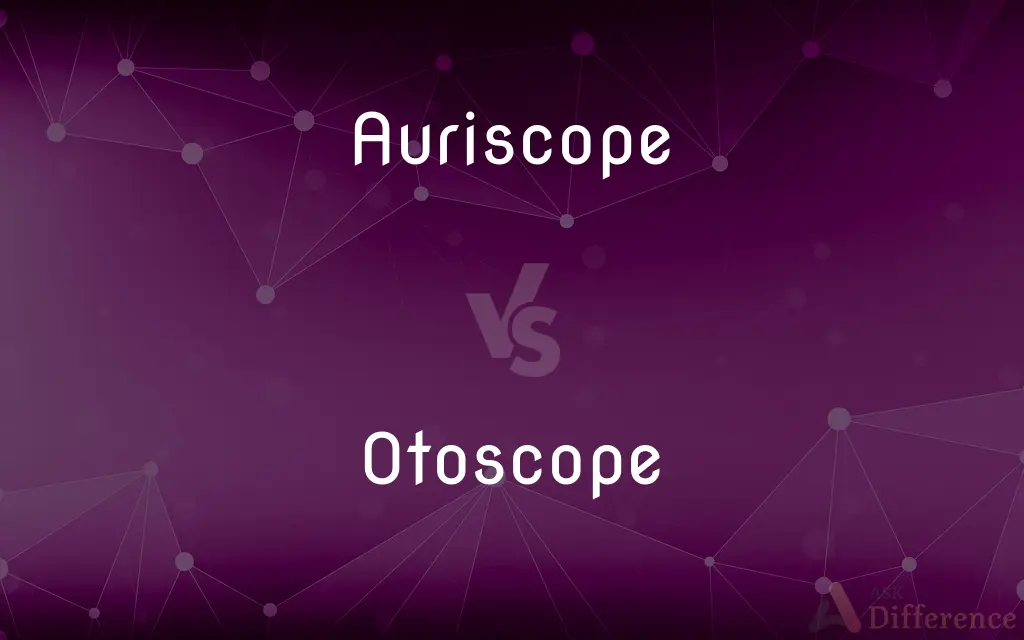Auriscope vs. Otoscope — What's the Difference?
By Tayyaba Rehman & Fiza Rafique — Updated on March 9, 2024
Auriscope is another term for otoscope, both used to examine the ear, highlighting primarily a linguistic preference rather than functional difference.

Difference Between Auriscope and Otoscope
Table of Contents
ADVERTISEMENT
Key Differences
Auriscope and otoscope are terms often used interchangeably in the medical field to refer to a device designed for visual examination of the ear canal and eardrum. The main distinction lies in linguistic preference, with auriscope being less commonly used in contemporary practice.
Both instruments play a crucial role in diagnosing ear infections, eardrum conditions, and more, enabling healthcare professionals to view the ear canal and tympanic membrane closely. While otoscope is the more widely recognized term, especially in the United States, auriscope might be encountered in certain regions or older literature, but it refers to the same tool.
The choice between auriscope and otoscope does not impact the functionality or the purpose of the instrument; it is purely a matter of terminology. In clinical settings, the preference for one term over the other may reflect regional linguistic variations, though otoscope remains the dominant term in medical literature and practice.
Despite the difference in nomenclature, both devices are essential for otolaryngologists (ear, nose, and throat specialists), pediatricians, and general practitioners for conducting ear examinations, showcasing the importance of ear health in overall medical care.
Comparison Chart
Term Usage
Less commonly used
More commonly used
ADVERTISEMENT
Linguistic Preference
Might be preferred in certain regions or older literature
Widely recognized, especially in the United States
Functionality
For examining the ear canal and eardrum
For examining the ear canal and eardrum
Medical Relevance
Essential for diagnosing ear conditions
Essential for diagnosing ear conditions
Specialty
Used by otolaryngologists, pediatricians, and general practitioners
Used by otolaryngologists, pediatricians, and general practitioners
Compare with Definitions
Auriscope
A tool for ear examination.
The doctor used an auriscope to check for signs of infection in the patient's ear.
Otoscope
Diagnostic device for the ear.
The otoscope revealed a buildup of wax obstructing the ear canal.
Auriscope
Part of routine ear exams.
During the physical exam, the pediatrician used an auriscope to examine the child's ears.
Otoscope
Facilitates ear canal and eardrum examination.
The otoscope allows for a detailed examination of the ear drum's condition.
Auriscope
Used in medical diagnostics.
An auriscope helps in identifying abnormalities within the ear canal.
Otoscope
Widely used in clinics and hospitals.
Every exam room in the clinic is equipped with an otoscope for ear assessments.
Auriscope
Instrument for otolaryngology.
Auriscopes are essential tools in the field of otolaryngology for assessing ear health.
Otoscope
Key tool in pediatric and general practice.
Otoscopes are indispensable in diagnosing ear issues in both children and youngs.
Auriscope
Visual inspection device.
With an auriscope, visual inspection of the tympanic membrane becomes easier for healthcare providers.
Otoscope
Essential for ear infection diagnosis.
The use of an otoscope can confirm the presence of an ear infection.
Auriscope
Another term for otoscope
Otoscope
An otoscope or auriscope is a medical device which is used to look into the ears. Health care providers use otoscopes to screen for illness during regular check-ups and also to investigate ear symptoms.
Auriscope
An instrument for examining the condition of the ear.
Otoscope
An instrument designed for visual examination of the eardrum and the passage of the outer ear, typically having a light and a set of lenses.
Auriscope
An instrument for examining the condition of the ear.
Otoscope
An instrument for examining the interior of the ear, especially the eardrum, consisting essentially of a magnifying lens and a light.
Otoscope
(medicine) An instrument used for examining the eardrum and interior of the outer ear.
Otoscope
An instrument for examining the condition of the ear.
Otoscope
Medical instrument consisting of a magnifying lens and light; used for examining the external ear (the auditory meatus and especially the tympanic membrane)
Common Curiosities
What is an auriscope used for?
An auriscope is used for examining the ear canal and eardrum to diagnose various ear conditions.
Is there a difference between an auriscope and an otoscope?
Functionally, no. The difference lies primarily in the terminology used, with "otoscope" being more commonly employed.
Can an auriscope be used for routine ear exams?
Yes, auriscopes are commonly used in routine physical exams to assess the health of the ear.
Can an auriscope diagnose ear infections?
Yes, an auriscope can be used to diagnose ear infections by allowing a healthcare provider to view the ear canal and tympanic membrane.
Can using an auriscope prevent ear conditions?
While not preventative, regular use of an auriscope in exams can lead to early detection and treatment of ear conditions.
Are auriscopes and otoscopes used by specific medical specialists?
Yes, they are used by otolaryngologists, pediatricians, and general practitioners for ear examinations.
Is the use of an otoscope limited to diagnosing infections?
No, otoscopes are used for a variety of ear examinations, including checking for wax buildup, eardrum damage, and more.
Why is the otoscope more widely used than the auriscope?
The term "otoscope" is more prevalent in medical literature and practice, especially in the United States, making it more widely recognized.
How do auriscopes help in ear health?
Auriscopes allow for the early detection and diagnosis of ear conditions, contributing to effective treatment and ear health management.
Are there different types of otoscopes?
Yes, there are various types of otoscopes, including standard, video, and pneumatic, each with specific uses.
What makes otoscopes essential in pediatric care?
Otoscopes are key in diagnosing common pediatric ear issues, such as infections and fluid buildup, ensuring timely treatment.
How does the use of an otoscope improve patient care?
By facilitating the diagnosis of ear conditions, otoscopes enable targeted treatment, improving patient outcomes.
Do auriscopes and otoscopes require special training to use?
Yes, healthcare providers receive training to effectively use these instruments for ear examinations.
Is there a preference for auriscope or otoscope in different countries?
The preference may vary, with "otoscope" generally being more popular globally, but both terms refer to the same device.
How has the design of otoscopes evolved over time?
Otoscope designs have evolved to include features like enhanced lighting, magnification, and digital imaging for improved examination.
Share Your Discovery

Previous Comparison
Kir vs. Kos
Next Comparison
Mercy vs. CompassionAuthor Spotlight
Written by
Tayyaba RehmanTayyaba Rehman is a distinguished writer, currently serving as a primary contributor to askdifference.com. As a researcher in semantics and etymology, Tayyaba's passion for the complexity of languages and their distinctions has found a perfect home on the platform. Tayyaba delves into the intricacies of language, distinguishing between commonly confused words and phrases, thereby providing clarity for readers worldwide.
Co-written by
Fiza RafiqueFiza Rafique is a skilled content writer at AskDifference.com, where she meticulously refines and enhances written pieces. Drawing from her vast editorial expertise, Fiza ensures clarity, accuracy, and precision in every article. Passionate about language, she continually seeks to elevate the quality of content for readers worldwide.














































